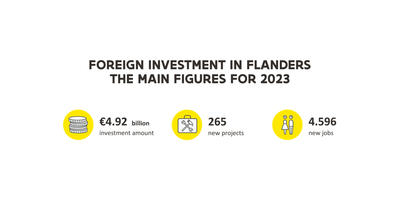
Why sharing is smart innovation in Flanders
All together on a postage stamp
It’s no secret that Flanders is among Europe’s finest for innovation. In the European Commission's 2019 Regional Innovation Scoreboard, the region even ranks second in the top 10 of strong innovators. What is the basis for this success?
Mark Andries: “There are few regions where research institutes and private companies cooperate as closely as in Flanders. The accessibility of our local knowledge system has grown somewhat out of necessity. Many Flanders-based niche players lack the scale to carry out research and development on their own, which ‘condemns’ them to work together. At the same time, the government of Flanders has been investing intensively in the development of a connected ecosystem for R&D in high-tech areas since the 1990s. Our strategic research centers – imec, VITO, VIB and Flanders Make – are great examples of this approach.”
Philippe Muyters: “Behind these policy choices lies a clear long-term vision. If you look at today’s biggest innovations, for example, they are usually the result of cross-pollination between various disciplines. At the same time, companies are rolling out their innovations at an accelerating pace as they face a growing number of competitors due to increasing globalization.
To achieve the required multidisciplinary approach and speed, open innovation is crucial: companies and research institutions need to work together to find solutions to societal problems. Fortunately, Flanders can rely on strong assets to achieve just that. The fact that we’re all together ‘on a postage stamp’ is one key example. The bright and bold minds needed to innovate with flying colors can be found here within just a few miles of one other.
In addition to this personal proximity, Flanders guarantees a bottom-up environment: the government supports innovation without being in the driver’s seat. For example, our strategic research centers can freely use a variety financial instruments to experiment in collaboration with the business world. Moreover, doctoral researchers have the possibility to innovate not only at universities, but within companies.”
Claire Tillekaerts: “There’s no doubt that Flanders supports open innovation. In addition, we also focus on initiatives that strengthen our global innovation position by pursuing international cooperation models. Networking is as crucial for this as it is for innovation itself. To give just one example, there’s the renowned TCI congress, which FIT and VLAIO are organizing together this year and which is also supported by Visit Flanders. Thanks to this initiative, Flanders attracts the attention of clusters from abroad as well as international cluster experts. At the same time, we bring Flanders’ clusters into contact with foreign stakeholders so that they can grow into global players capable of valorizing innovations from Flanders internationally.”
Flanders can rely on strong assets. The fact that we're all together ‘on a postage stamp' is one key example. The bright and bold minds needed to innovate with flying colors can be found here within just a few miles of one other.
Shared commitment
Flanders is home to two types of cluster organizations: spearhead clusters and innovative business networks. Why this distinction?
Philippe Muyters: “For some strategic domains, Flanders aims to continue expanding and strengthening its leading position in the long term. Think of sustainable chemistry, logistics, food, energy, the blue economy and so on. Each of our spearhead clusters has been set up around such a theme. They each develop a vision and strategy for at least ten years to keep Flanders relevant – now and in the future.”
Mark Andries: “For this purpose, the spearhead clusters receive up to EUR 500,000 in operating resources per year, provided that the participating companies and organizations contribute the same amount. In addition, EUR 95 million is made available each year for individual research and innovation projects that are launched via the clusters to strengthen the competitiveness of their members.”
Philippe Muyters: “To use all these resources efficiently, it’s essential to make smart choices. After all, not all domains are of equal strategic importance for Flanders. However, this does not mean that other industries can’t benefit from cross-sectoral collaboration. This is where innovative business networks come in. They are created exclusively at the initiative of companies that unite around a specific innovation project and receive government support for three years.”
Mark Andries: “The conditions and targets for innovative business networks are less strict than for spearhead clusters. The aim is to lower the threshold for open innovation. The participating companies have more room to experiment and test different courses of action. Nevertheless, we ask each network to invest an equal amount of money as the government – just like the spearhead clusters. In the end, it’s all about shared commitment.”
Looking over organizational walls
Flanders’ clusters make every effort to facilitate cooperation between companies and sectors. But do they themselves also work together?
Philippe Muyters: “Absolutely! There’s even a specific budget for projects in which clusters join forces across their own borders. Moreover, regular consultation between fellow clusters is an official target for all cluster organizations. That's a good thing: it’s only by looking over your own organizational walls and by sharing ideas, methods and concepts that you come up with solutions that you could have never thought of by yourself.”
Mark Andries: “VLAIO also supports consultation between fellow clusters. For example, our account managers organize quarterly meetings in which the various cluster managers share best practices, practical advice and learnings in a relaxed atmosphere. Furthermore, all clusters are part of the ‘VLAIO Network’. This also includes numerous companies and organizations that inspire each other across disciplines and sectors, from interest groups and federations to knowledge and research centers, local authorities, government institutions and service providers such as banks, accountants and consultants.”
Claire Tillekaerts: “In addition to supporting local cooperation, it is essential to attract foreign players who can increase innovation in our clusters. At the same time, we must also encourage Flanders’ clusters to look across territorial borders and offer solutions abroad. Sometimes clusters are not always aware of what their foreign counterparts do, or which opportunities there are to join forces. To map out these international cluster activities and opportunities, FIT's foreign network, among other things, is an important enabler.”
In addition to supporting local cooperation, it is essential to attract foreign players who can increase innovation in our clusters. At the same time, we must also encourage Flanders' clusters to look across territorial borders and offer solutions abroad.
Mission-driven innovation without borders
What does the future hold for Flanders’ clusters?
Mark Andries: “Until now, Flanders’ clusters have mainly been focusing on research projects or development projects – or a combination of both – with clear returns on investment. The aim? Not to innovate for the sake of innovation, but to boost both business and the economy. One of the most recent projects explicitly adds an ecological mission to this picture.
The project was named ‘Moonshot’. But instead of going to the moon, we want to move Flanders towards a CO2-neutral industrial sector by 2050. What makes this project so special is the fact that it’s supported by all clusters together, with one cluster – Catalisti, our spearhead cluster for sustainable chemistry – in the lead. I can only applaud the fact that Flanders’ clusters are fostering even closer ties to work towards a clear mission for the future of our society.”
Philippe Muyters: “Over the past five years, we have laid solid foundations for such a mission-driven and multidisciplinary future. However, we have always consciously adopted a so-called ‘ink spot strategy’. The idea is to develop strong local clusters first, and only afterwards focus on internationalization. Today, we are certainly ready for this next step.”
Claire Tillekaerts: “Internationalization is definitely a must to safeguard the competitiveness of Flanders’ spearhead clusters and innovative business networks. FIT’s foreign network plays an essential role in this. For example, our technology counselors can map out similar clusters abroad and connect them with Flanders-based clusters.
By internationalizing Flanders’ clusters, we are contributing to the internationalization of our entire economy. When clusters go international, they put technologies and craftsmanship from Flanders in the spotlight worldwide. This, in turn, strengthens Flanders’ position in a global context.”
Until now, Flanders' clusters have mainly been focusing on research projects or development projects – or a combination of both – with clear returns on investment. One of the most recent projects explicitly adds an ecological mission to this picture. The project was named ‘Moonshot'. But instead of going to the moon, we want to move Flanders towards a CO2-neutral industrial sector by 2050.


